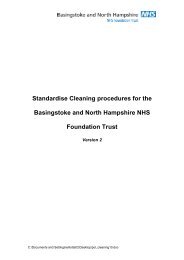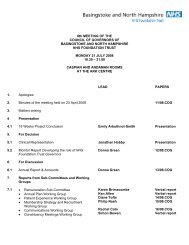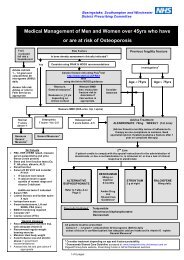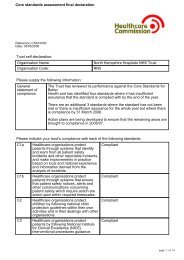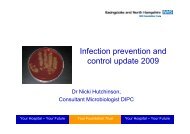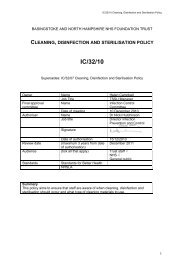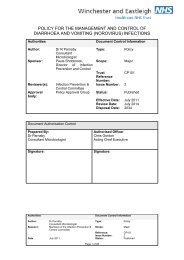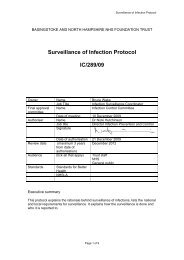Isolation and infectious diseases policy - Hampshire Hospitals NHS ...
Isolation and infectious diseases policy - Hampshire Hospitals NHS ...
Isolation and infectious diseases policy - Hampshire Hospitals NHS ...
Create successful ePaper yourself
Turn your PDF publications into a flip-book with our unique Google optimized e-Paper software.
Winchester & Eastleigh Healthcare <strong>NHS</strong> Trust<br />
Policy for <strong>Isolation</strong> <strong>and</strong> Infectious Diseases Policy<br />
Transfers should only take place if unavoidable, <strong>and</strong> in the patient’s best<br />
interest, i.e. the health of the patient should take priority over the infection<br />
problem. The receiving ward must be informed <strong>and</strong> a single room or<br />
appropriate cohort area arranged.<br />
Please see CP061 Policy for the Interward <strong>and</strong> Intraward Transfer of patients<br />
with infection control issues.<br />
12.0 HOUSEKEEPING STAFF AND CLEANING<br />
12.1 Housekeeping staff must wear the same protective clothing as the nursing<br />
staff when entering an isolation room. The yellow isolation sign on the door<br />
warns that the patient is being isolated but not the reason why. Housekeeping<br />
staff must check with the nurses what precautions are required before<br />
entering the room.<br />
See Appendix 2 for details on how to clean the isolation room (single or<br />
cohort) on a daily basis <strong>and</strong> a how to carryout a ‘terminal clean’ when the<br />
patient is discharged from the room. Hydrogen Peroxide Vapour technology<br />
(currently Bioquell machine) may be used to disinfect the room.<br />
Housekeeping provide this service.<br />
12.2 The staff must inform the housekeeping staff that a patient is being isolated<br />
<strong>and</strong> what precautions, gloves <strong>and</strong> aprons etc are required. The isolation room<br />
or bay should be thoroughly cleaned every day to minimize the dust <strong>and</strong><br />
reduce airborne spread. When the patient is discharged the room should be<br />
‘deep cleaned’. Please refer to CP030 Overarching Decontamination Policy<br />
for specific details.<br />
13 REVIEW OF ISOLATION REQUIREMENT<br />
Regular assessment <strong>and</strong> evaluation of the continued need for isolation should<br />
be taken in conjunction with the IC team. To find out the suggested duration of<br />
isolation please refer to the Appendix 8 Communicable Disease Table or<br />
contact the Infection Prevention <strong>and</strong> Control Team.<br />
<strong>Isolation</strong> can be stopped when:<br />
The patient is no longer at risk of spreading infection to others<br />
The duration of isolation dictated by the specific disease <strong>and</strong> treatment<br />
criteria are met.<br />
16<br />
Authorities<br />
If in doubt contact the IPCT.<br />
Document Control Information<br />
Author:<br />
Sponsor:<br />
Date:<br />
Dr Kordo Saeed<br />
microbiologist<br />
Sue Dailly Lead Nurse<br />
Infection Prevention <strong>and</strong><br />
Control<br />
Paula Shobbrook Director of<br />
Infection Prevention <strong>and</strong><br />
Control<br />
01/08/11<br />
Type:<br />
Scope:<br />
Reference:<br />
Issue No:<br />
Status:<br />
Policy<br />
Major<br />
CP022 (IC 04)<br />
4<br />
Published



